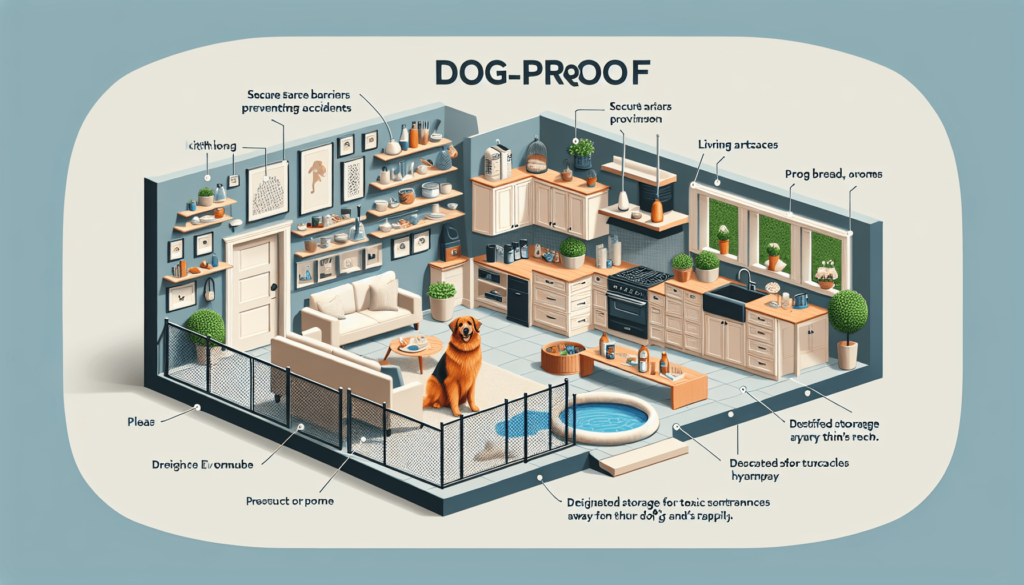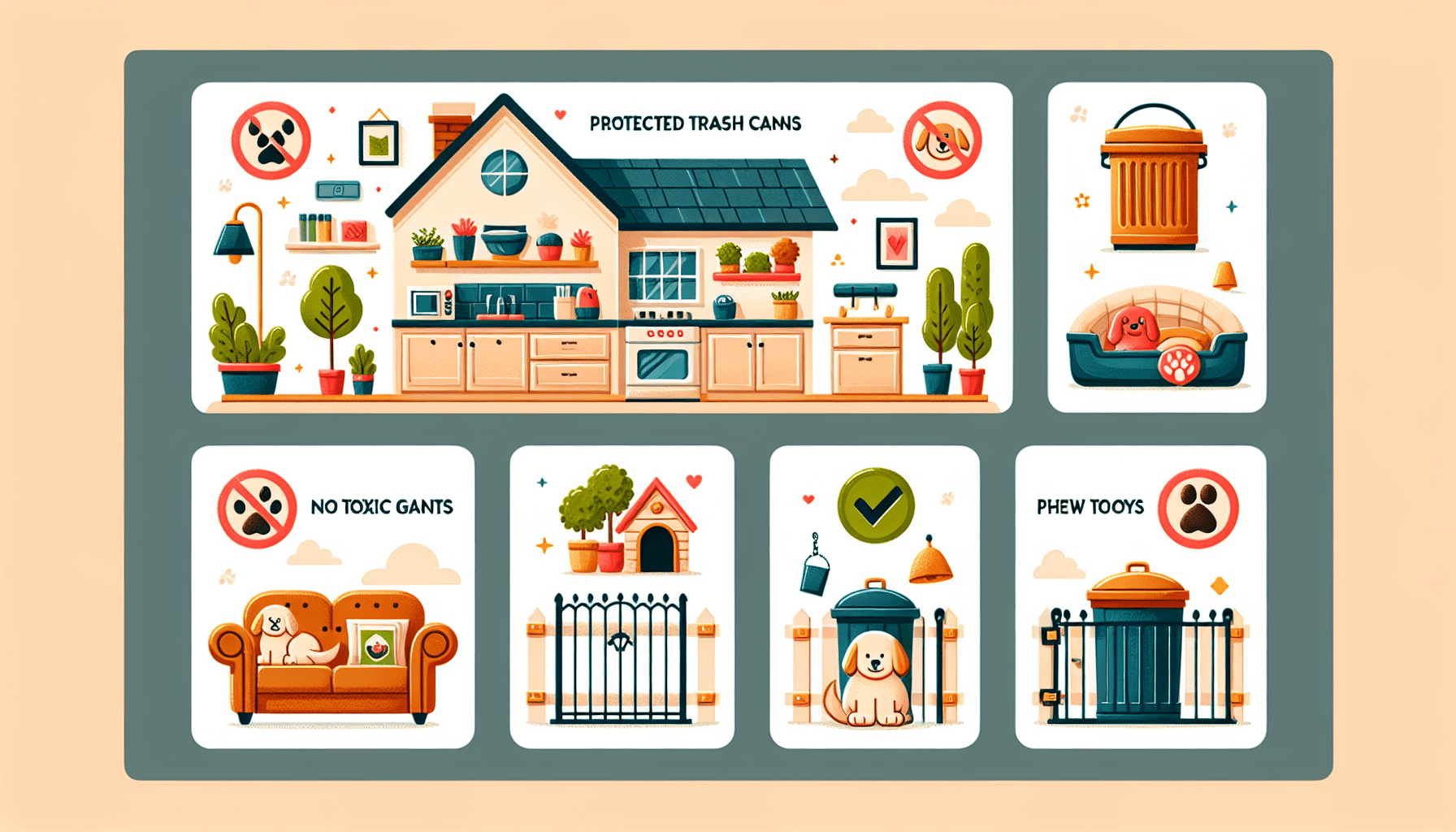You adore your furry friend, but sometimes their playful nature can lead to some chaos around the house. In this article, discover some simple and effective tips on how to make your home dog-proof. From securing loose wires to choosing the right furniture, you’ll find practical advice to create a safe and welcoming environment for your beloved pup. So, let’s explore these easy steps together and ensure a happy and harmonious living space for both you and your four-legged companion.
Secure Hazardous Areas
Keeping your dog safe in your home is of utmost importance. One of the first steps in creating a dog-proof environment is to secure hazardous areas. This means blocking off stairs to prevent your furry friend from taking a tumble. You can use baby gates or barriers specifically designed for dogs to achieve this. Make sure to choose a sturdy gate that your dog cannot easily push through.
Another crucial aspect of securing hazardous areas is to lock cabinets and drawers. Household cleaning products, medications, and other chemicals should be stored in locked cabinets. Dogs are naturally curious and may accidentally ingest harmful substances if they have access. By keeping these items locked away, you can minimize the risk of your dog getting into something dangerous.
In addition to locking cabinets, it’s important to cover electrical outlets. Puppies, in particular, may be tempted to chew on cords or stick their paws in outlets. Invest in outlet covers or deterrent sprays to prevent any electrical accidents.
Lastly, secure trash bins to keep your dog from rummaging through waste. Dogs are attracted to the smells coming from the trash and may ingest something harmful. Choose a bin with a secure lid or place it in an area that is inaccessible to your furry friend.
Protect Valuable Items
Dogs are curious creatures and may not always understand the value of your belongings. To protect your valuable items, it’s essential to make sure they are out of reach. Fragile items, such as vases or delicate decor, should be stored in areas that your dog cannot access. Consider using higher shelves or enclosed display cases to keep these items safe.
Additionally, if you have furniture that holds sentimental or monetary value, it’s a good idea to protect it with slipcovers or blankets. Dogs may jump on furniture or accidentally scratch it while playing. By using slipcovers or blankets, you can create a barrier that prevents any damage.
Small items that can be swallowed pose a choking hazard for dogs. Be sure to put away any objects that could potentially be ingested, such as small children’s toys, coins, or jewelry. It’s always better to be safe than sorry, so take the time to remove any small items from your dog’s reach.

Create Safe Outdoor Spaces
While it’s important to create a dog-proof indoor environment, don’t forget about your outdoor spaces. Dogs love spending time outside, and it’s crucial to ensure their safety in this environment as well.
To start, consider installing a secure fence around your yard. A sturdy fence will not only keep your dog within the confines of your property but also prevent unwanted intruders from entering. Choose a fence that is tall enough to prevent your dog from jumping over it and make sure there are no gaps or holes that could allow your dog to escape.
Take some time to familiarize yourself with the plants in your yard, as some can be toxic to dogs if ingested. Remove any toxic plants or relocate them to an area where your dog will not have access. It’s always a good idea to consult with a veterinarian or do some research to ensure the plants in your yard are safe for your furry friend.
Just like humans, dogs need shade and water when they spend time outdoors. Make sure there is a shaded area in your yard where your dog can cool off during hot days. Provide fresh water in a bowl or invest in a self-filling water dispenser. By providing shade and water, you can prevent your dog from overheating and becoming dehydrated.
Remove Potential Choking Hazards
Choking hazards can be present throughout your home, so it’s essential to identify and remove them. Start by picking up small toys or objects that your dog could potentially swallow. Children’s toys, small balls, or even loose buttons should be stored in areas where your dog can’t reach them. Always be mindful of any tiny items that could pose a choking hazard.
Remote controls and cords can also be dangerous for dogs. Dogs may chew on cords, which can lead to electrocution or choking. Keep cords out of reach and consider using cord protectors to prevent chewing. Remote controls should be stored in secure areas or raised surfaces where your dog cannot access them.
Window blinds and curtain cords can also pose a choking risk. Dogs may become entangled in the cords or attempt to chew on them. To prevent accidents, secure window blinds and curtain cords out of your dog’s reach. Consider using cordless blinds or tie the cords up and out of the way.

Prevent Access to Harmful Substances
Dogs are naturally curious, and certain household substances can be toxic to them. It’s essential to store cleaning products, medications, and chemicals in locked cabinets or high shelves. Cleaning products, such as bleach or detergents, can be harmful if ingested by your dog. Keep them out of reach to prevent accidental poisonings.
In addition to cleaning products, be mindful of the household products you use around your dog. Some common household items, such as certain essential oils or air fresheners, can be harmful to dogs. Opt for pet-friendly alternatives to ensure the safety of your furry friend.
Eliminate Escape Routes
Preventing your dog from escaping is crucial for their safety. Regularly inspect your fences and gates, and repair any holes or gaps promptly. Dogs are skilled at finding ways to escape, so it’s important to ensure that your yard is secure. By maintaining the integrity of your fences and gates, you can prevent your dog from venturing into potentially harmful situations.
Windows and doors are common escape routes for dogs. Secure windows by using window locks or installing window screens. Make sure all doors leading outside are properly closed and consider adding door alarms to notify you if they are opened. Taking these measures will help keep your dog safely within your property.
Microchipping your dog is another important step in eliminating escape routes. Even with the most secure environment, accidents happen, and dogs can sometimes find a way to get lost. Microchipping provides an added layer of protection by ensuring that your dog can be easily identified and returned to you if they are found.
Provide Safe Chew Toys
Dogs have a natural instinct to chew, and providing appropriate and safe chew toys is essential. Offering a variety of dog-friendly chew toys will keep your furry friend entertained while also saving your belongings from potential damage. Look for toys specifically designed for chewing and ensure they are the appropriate size for your dog.
It’s important to avoid toys with small parts that can be easily swallowed or become a choking hazard. Always supervise your dog while they play with toys and remove any broken or damaged toys immediately. Regularly rotate the toys to keep your dog engaged and interested in their collection.
Set Up a Comfortable and Secure Rest Area
Creating a designated rest area for your dog is essential for their comfort and safety. Provide a dog bed or crate that is specifically for your furry friend. Having their own space allows them to feel secure and provides them with a sense of belonging within your home.
Make the rest area cozy and inviting by adding soft bedding and blankets. Dogs love having a comfortable place to relax and rest. Consider adding some of their favorite toys or a blanket with your scent to make them feel even more at ease.
Choose a quiet location for the rest area to minimize disturbances and create a calming environment for your dog. Avoid placing the rest area in high traffic areas or areas with a lot of noise. Providing a peaceful space for your dog to rest will contribute to their overall well-being.
Establish a Consistent Routine
Dogs thrive on routine, and establishing a consistent schedule is integral to their happiness and well-being. Stick to a regular feeding schedule to maintain a sense of stability for your furry friend. Feeding your dog at the same times each day also helps with potty training, as their bathroom habits become more predictable.
Designate specific areas for potty breaks, both indoors and outdoors. Consistently taking your dog to these designated areas will help reinforce good bathroom habits. Be patient and consistent while potty training, as accidents are bound to happen during the learning process.
Provide daily exercise and mental stimulation for your dog. Dogs have boundless energy and need an outlet for their physical and mental needs. Regular walks, playtime, and training sessions will help keep your dog happy and prevent them from becoming bored or anxious.
Keep a Watchful Eye
As a responsible dog owner, it’s crucial to always keep a watchful eye on your furry friend. Monitor their behavior and take note of any potential hazards that you may have missed. Regularly inspect your home for any new items or areas that could pose a risk to your dog’s safety.
Supervise interactions between your dog, other pets, and visitors. Some dogs may become anxious or defensive in unfamiliar situations, so it’s important to be attentive and intervene if necessary. By closely monitoring their interactions, you can prevent any potential conflicts or accidents.
Finally, be attentive to any changes in your dog’s health or well-being. Dogs cannot verbalize their discomfort, so it’s up to you to be their advocate. Keep an eye out for any changes in appetite, behavior, or physical appearance. Regular vet check-ups are also vital to catch any potential health issues early.
By following these tips and creating a dog-proof environment, you can ensure the safety and well-being of your furry friend. Remember, a dog-proof home is a happy home for both you and your beloved companion.

